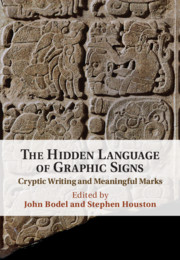Book contents
- The Hidden Language of Graphic Signs
- The Hidden Language of Graphic Signs
- Copyright page
- Contents
- Contributors
- Abbreviations
- Introduction
- Part I Hidden Writing
- Part II Legible Signs
- Seven Marking and Writing in an Egyptian Workmen’s Community
- Eight The Semiotics of Signa and the Significance of Signs in Roman Stamps
- Nine Late Antique and Early Medieval Monograms
- Ten Crests and Familial Identity in Medieval Japan
- Eleven Where Credit’s Due
- Twelve From Modeling to Destruction
- References
- Index
Seven - Marking and Writing in an Egyptian Workmen’s Community
from Part II - Legible Signs
Published online by Cambridge University Press: 23 August 2021
- The Hidden Language of Graphic Signs
- The Hidden Language of Graphic Signs
- Copyright page
- Contents
- Contributors
- Abbreviations
- Introduction
- Part I Hidden Writing
- Part II Legible Signs
- Seven Marking and Writing in an Egyptian Workmen’s Community
- Eight The Semiotics of Signa and the Significance of Signs in Roman Stamps
- Nine Late Antique and Early Medieval Monograms
- Ten Crests and Familial Identity in Medieval Japan
- Eleven Where Credit’s Due
- Twelve From Modeling to Destruction
- References
- Index
Summary
Chronograms are a cryptographic written practice in which the numerical values of some letters of a text encode a date relevant to that text. They constitute a form of ludic numeracy ‒ a specific kind of ludic language or wordplay in which writers not only highlight their skill with words and numbers but also conceal information, forcing readers to expend effort to extract their hidden meanings. Four distinct chronogram traditions are outlined: South and Southeast Asian word-symbols, South Asian alphasyllabic numerals; Greek, Hebrew, and Arabic alphanumeric chronography; and the early modern Western European tradition using Roman numerals. This chapter analyzes a corpus of over 10,000 Roman numeral chronograms from the fourteenth through the twentieth centuries, drawn from those previously compiled by the antiquarian James Hilton. Roman numeral chronograms use the letters IVXLCDM, specially marked within texts, to encode dates.While these chronograms began prior to the Hindu-Arabic (Western) numerals’ ubiquitous use, they were most popular in the late seventeenth and early eighteenth centuries, by which time the Roman numerals were already archaic. It was thus just at the point when Roman numerals were falling out of everyday use that they were ripe for symbolic repurposing in chronograms.
Keywords
- Type
- Chapter
- Information
- The Hidden Language of Graphic SignsCryptic Writing and Meaningful Marks, pp. 159 - 172Publisher: Cambridge University PressPrint publication year: 2021

